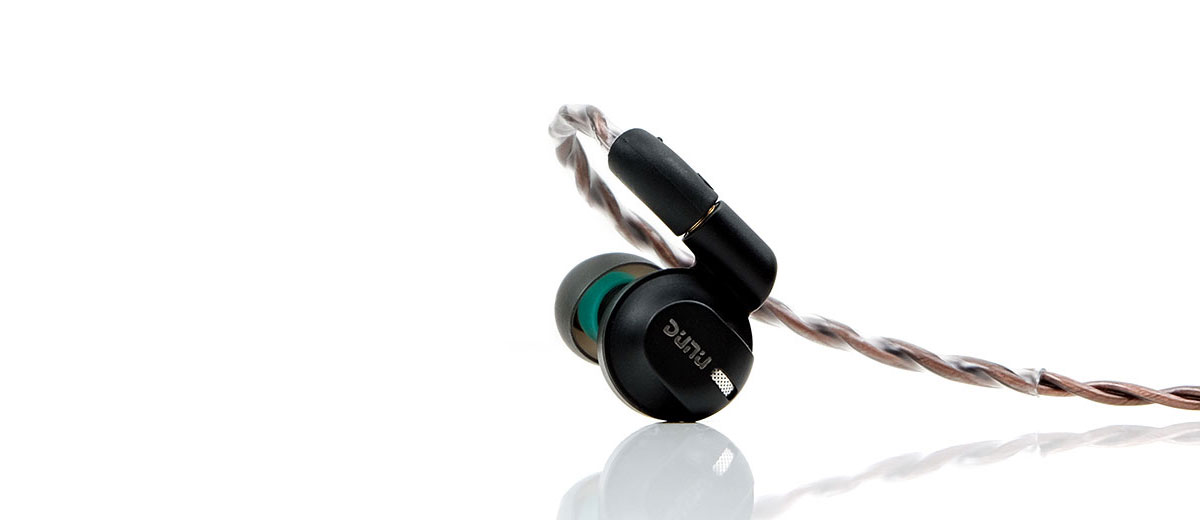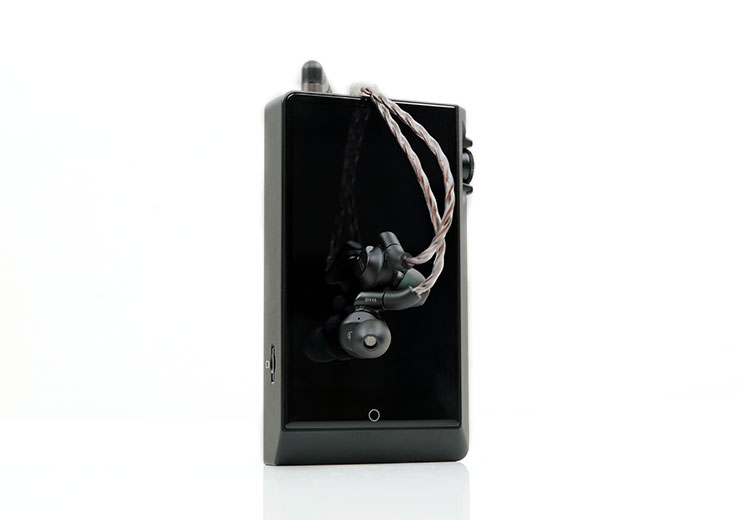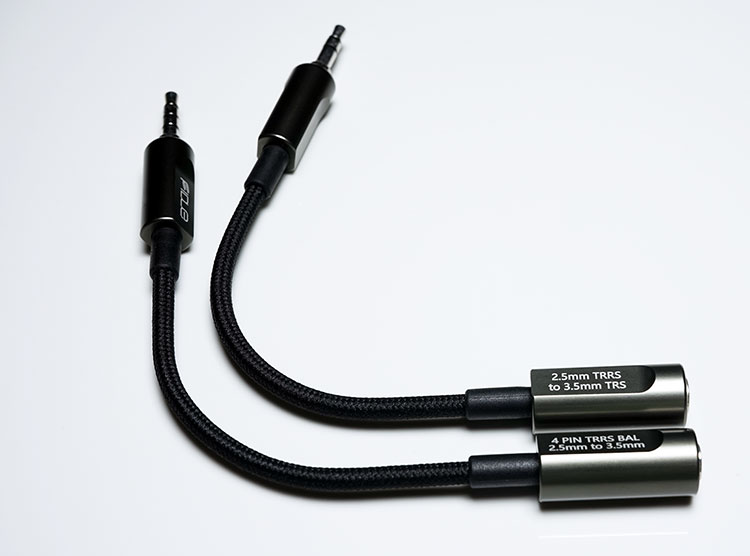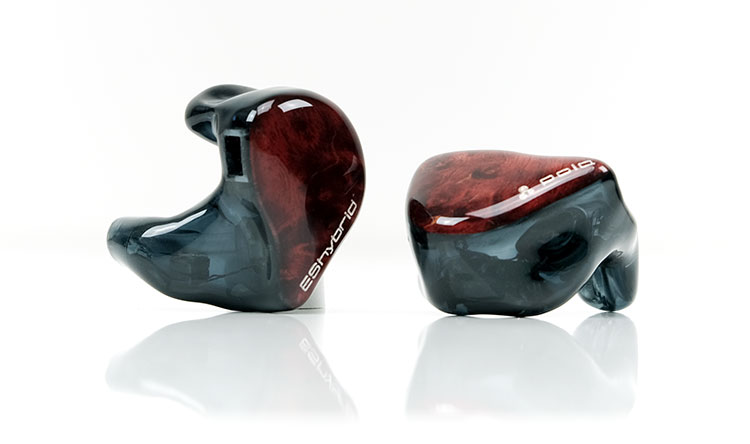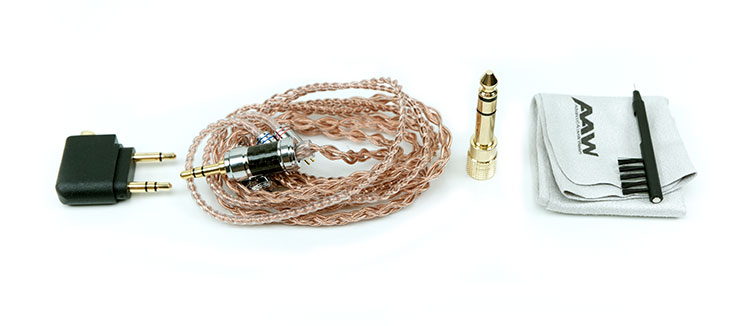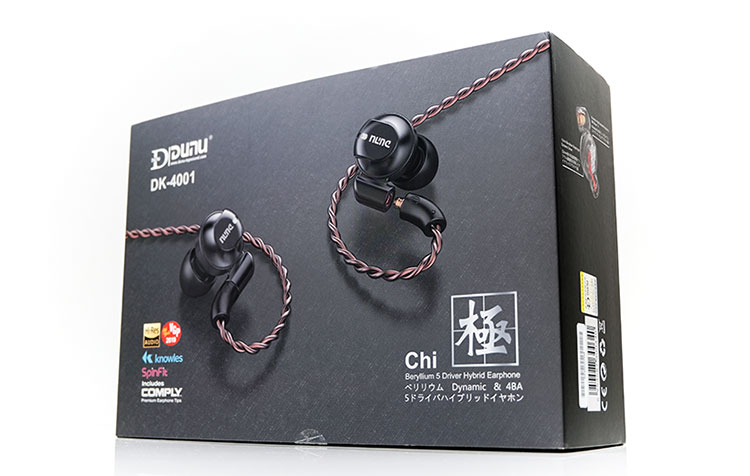Sound Impressions
Summary
This is an impressive and perhaps a unique hybrid sound for me in today’s market. Certainly, it is a signature that grows on you the more you listen to it. There is some clever tuning going on with the DK-4001 to produce a powerful but slightly euphonic twist to its tone that places a lot of emphasis on a physically dense low-end, a strong female vocal and a relaxed top-end.
There are bumps in the FR for sure, but nothing seems overly abrasive or bloomy. You get a presentation that errs to the musical but slightly forgiving side rather than a clean or high-contrasting alternative that some hybrids tend to rely on for the excitement factor.
Much of the DK-4001 tuning magic is in keeping the beryllium driver in play right up to the highs with a crossover point I suspect around 5-6k. The tone and weight of the dynamic driver are excellent with a fantastic deep extension and plenty of mids presence that tips vocal positioning to the fore, just where I like it.
The timbre is on the smoother side. DUNU has rolled off the top-end beyond 7k so it doesn’t deliver huge sparkle but also helps attenuate any potential sharp overtones that may creep into the timbre such as sibilance. Some might prefer to hear a more aggressive and brighter treble in their listening but for me, the fantastic treble body and slightly wetter tone of the DK-4001 highs are plenty addictive, especially with a neutral source.
Staging
The staging is a little on the closer side with that forward sub-to-mid-bass positioning, forward vocal and mids and slightly attenuated upper treble. However, depth is excellent with a superb extension right down to 20-30Hz and little sign of any roll-off there.
Staging width is not on the grand side of things but it successfully avoids sounding hollowed out or recessed. For my money, the DK-4001 midrange instrumental presence is a lot more open and spacious sounding than the likes of the hybrid Polaris II which sounds veiled in comparison once the low-end gets busy.
Headroom might be considered one of the DK-4001’s weaknesses due to that roll-off beyond 7k so you do not get an airy clean sound such as you might find on the Solaris. Mind you, I think that’s done on purpose as from what I am told that is a bit closer to the DUNU house sound.
Higher pitched instrumental and vocal positioning is to the fore and stretches aspects of the staging further forward. Especially so for female vocals which leap out a lot more but without getting terribly shouty or edgy in tone due to a small upper-mids dip around 3-4k.
Bass
This is the DK-4001’s strength in many ways. It extends deep with excellent articulation, spaciousness, and layering. However, DUNU has tuned the low-end to avoid bloat and an over-reliance on sub-bass parlor tricks. Rather, it is physical, weighty but also very nicely balanced with a fairly linear curve from 30-80Hz and a gentle drop to 800hz.
This tuning is perfect for classic rock and synth-wave genres where you want that bass fundamental to be solid but not overpowering. By comparison, the CA Polaris II dynamic driver has a much stronger sub-to-mid-bass elevation that can overpower its dipped midrange.
The DK-4001 straddles a middle-path rather nicely with excellent power, not too much mid-bass emphasis and a smooth transition into the lower-mids with minimal bleed. Artists such as Code Elektro are nailed on perfect for the DK-4001 sound. Check out Voyager from their Wolf album if you get a chance to demo the DK-4001 ability to deliver outstanding reach and low-end clarity.
Given that DUNU elected to allow the 13mm beryllium driver to cover both the lows and mids rather than insert an additional BA midrange driver this could account for that generally excellent level of coherence in the DK-4001 low-to mids performance.
Mids
Mids have a gentle rise from 800Hz to around 2k with a nice emphasis on all but the highest-pitched vocal performances. Lower pitched instrumental positioning is a little more neutral in terms of positioning so they take up space just behind all but the lower vocal registers.
DUNU has resisted dipping the DK-4001 mids to provide that typical v-shaped “exciting” high-contrast sound and allowed the mids to breathe with a bit more space for both vocals and instruments. Thank you for that!
There is a small dip around 3-4k though nothing sucked out that would kill vocal spacing and presence. It is enough to balance out the lower-treble emphasis and prevent percussion from sounding overly dominant and splashy sounding.
The upper treble roll-off and stronger dynamic driver performance does, however, produce that smoother slightly euphonic tone to the DK-4001 timbre. You will, therefore, be hard-pressed to hear anything sibilant or with sharp edgy overtones in the DK-4001 midrange for both instruments and vocals.
Treble
DUNU has given the DK-4001 more of a lower-treble emphasis up to 7k and faded the upper treble a bit more beyond with a bit of a roll-off.
This contrasts with the likes of the Polaris II and the IE800 which tries to extend the treble presence that bit more to produce a higher level of contrast with their bass tuning. Certainly, compared with the similarly priced AAW/Shozy POLA’s electrostatic high-end tuning it is not a match in terms of articulation and headroom.
What DUNU seems to be aiming for with the DK-4001 treble tuning is ‘body’ and a level of refinement that will take out any potential edginess from the vocal and instrumental timbre in the presentation without it sounding dark.
If that is the case, then it certainly works. Percussion timbre has a solid if slightly wet tone, instrumental and vocal timbre is more even-harmonic biased and generally the top-end allows the DK-4001 to deliver a non-fatiguing treble.
Matchability
Efficiency & Noise
The DK-4001 is rated at 32Ω and 112dB SPL which makes it fairly easy to drive but does require a little more current juice or volume than some other hybrids out there. In our compared monitors, only the POLA’s much less efficient 101dB SPL required more current than the DK-4001 with other hybrids such as the Fidue A91 and the Polaris II being that bit easier for loudness.
That being said, the DK-4001 is noise friendly and you will not hear much in terms of hiss, if any at all, from DAPs such as the Lotoo PAW Gold Touch, iBasso DX220/AMP 1 MKII, Cayin N6ii, and even the noisier HiBy R6 Pro. All of these DAPs have plenty of power to drive the DK-4001 with ease, especially is using the 2.5mm TRS or 4.4mm balanced jack options on the DK-4001 stock Noble cable.
Synergy
The slight euphony of the DK-4001 timbre and the physically dense sound of the low-end really suits a neutral DAP which focuses on instrumental separation and clarity. You can get away with the R6 Pro pairing in its stock format or with MSEB and a slight emphasis on the ‘crisp’ setting by about 10-20 points if you want a little more treble emphasis.
Personally, I went with the DX220 and especially the Lotoo PAW Gold Touch. The Touch did a wonderful job bringing out a very black background, superior imaging to the Cayin N6ii and a naturally more forward sounding treble response. I felt the DK-4001/Lotoo pairing sounded very open with excellent instrumental separation. The detailed reference sound of the Touch also prevented the DK-4001 from sounding overly smooth or compressed in the mids.
The DX220/AMP1 MKII delivered a very similar presentation with perhaps just slightly less treble forwardness and a generally lighter tone to the bass. This pairing seems to focus more on delivering more of an expansive and very open sound with outstanding instrumental separation.
When compared to the N6ii’s bias to delivering a chunkier mid-range timbre the DK-4001 tended to sound technically more proficient and detailed also. Overall I felt the N6ii’s warmer presentation to clash a bit with the DK-4001’s more euphonic tendencies.
Select Comparisons
Fidue A91 ‘Sirius’
$899
Technical
The A91 is priced the same (SRP), is also a hybrid 5-driver with a single 10mm dynamic driver for the lows and a quad BA design for the mids and highs. There is no outright mention of the crossover points but we presume a 3-way as opposed to DUNU’s 2-way given the A91 drivers cover both mids and highs.
The A91 is rated at 20Ω and 113dB and is just a little more sensitive and easier to drive than the DK-4001. That means it will go louder faster than the DK-4001 but overall there is not a huge difference in terms of driving demands. Both will sound just fine on pretty much any decent DAP outside of specific synergy requirements. The fact that both come equipped with 2.5mm TRRS jacks as an option should make driving them that much easier.
Cable
Now, this is an interesting aspect for me as both have modular cable systems though the wiring is a bit different for each as also is the jack exchange method.
The A91 uses an 8-wire SPC compared to the Noble’s 4-wire OCC Copper and DHC pure silver wire. The A91 cable is jacketed in a black soft microphonic-free nylon jacket with zero memory retention. The Noble is a touch bouncier and has a bit more microphonics but it is also lighter and memory free with a much more striking brown finish to its jacket.
The connection system on the Noble is much more advanced even though both systems work equally well. The key difference is the use of pig-tail cable connections on the A91 which is a touch more cumbersome and weightier than the lower-profile ‘slide on and off’ system of the Noble jacks. They do both offer 3.5mm TRRS, 3.5mm TRS, as well as 2.5mm connections but the A91 is missing the new 4.4mm variant. That is an advantage to the Noble system.
Both are MMCX terminated with the A91 using an elegant screw lock system but on the older MMCX flat termination compared to the stronger more durable round socket of the DK-4001’s MMCX connector.
Performance
Both of these hybrid driver monitors have excellent dynamic driver tuning but they have a slightly different FR emphasis. First, the commonalities. Both extend really deep with little or no roll-off below 50-80Hz and have that beautiful dynamic driver natural levels of decay.
Where do they differ? Personally, I find the level of texture and detail in the DK-4001 slightly better. The A91 low-end up to 150Hz is also a little more neutral in quantity and sounds the slightly linear or cooler of the two signatures. The DK-4001 sub-t0-midbass has a bit more elevation and quantity. It is slightly warmer and denser in comparison as well as sounding more forward and offering a bit more texture.
Staging wise the DK-4001 has a bit more depth and power, however, the A91 has a tad more width and height. Imaging on the A91 is just that bit more complex sounding to my ear with that additional width and height to play with but at the cost of some vocal density and forwardness.
The DK-4001 vocals have a bit more body and sound the more forward of the two, especially higher-pitched female vocals. The DK-4001 does have a bit more euphony also to the vocal timbre with the A91 perhaps the more neutral and leaner sounding of the two performances.
Treble on the DK-4001 has more body but a bit more roll-off post 7k. The A91 dips a little more on the lower-treble with more emphasis on an 8-10k elevation so it has a bit more sparkle and headroom but also sounds the more ethereal of the two. Odd-harmonic overtones come into play a bit more on the A91 with a slightly cleaner but also a leaner percussion timbre than the DK-4001 wetter sound.
Campfire Audio Polaris II
$499
Technical
The Polaris II is a hybrid dual driver monitor with a 9.2mm Dynamic Driver cover the lows and mids and a single BA tweeter for the highs. That is a bit lower in terms of pure driver count from the 2 dual-tweeter BA and much larger 13.2mm dual-coated beryllium dynamic driver of the DK-4001 configuration.
One of the key differences between the Polaris II and the DK-4001 is the lack of tubes in the CA hybrid build. This is an extension of their design philosophy from their flagship Andromeda and Solaris that has been filtering down to the lower models for a while. The Polaris II uses CA’s T.E.A.C technology for a tubeless high-end tuning and a Polarity Tuned Chamber for the main DD driver.
The Polaris II is rated at 17Ω and 105dB compared to the 32Ω and 112dB SPL of the DK-4001. Despite what seems to be a lower SPL on the Polaris II, the DK-4001 32Ω rating does require more juice to drive. On most DAPs such as the DX220/AMP1 MK II and the Lotoo PAW Gold Touch, we did find ourselves pushing up the volume by 3-4dB (6-8 steps) to get a rough volume match.
Cable
Both use MMCX connectors but interestingly both cables have that same twisting jacket design. They both also use an SPC wire though there are differences with the Noble DK-4001 cable using OCC Copper and DHC pure silver wire and the Polaris II using an SPC Litz. Side by side the Polaris II stock cable seems to be using either less insulation or a smaller gauge since its built is much thinner.
Of course, the kicker is the interchangeable connection system of the Noble cable from the DK-4001. You get four possible connection variations with the DK-4001 with just the single-ended 3.5mm TRS for the Polaris II. Its a big advantage for DUNU.
Performance
The Polaris II is more v-shaped and more dipped in the mids than the DK-4001. It delivers a stronger sub-bass presence relative to its mids whereas the DK-4001 is more balanced in its sub-bass to lower-mids curve. The DK-4001 has a physical and relatively warm low-end but the Polaris II stacks it more on the sub-bass end with a cooler mid-bass and a more aggressive lower-mids dip.
Instruments, particularly on the lower-mids are a bit further back on the Polaris compared to the more forward sound of the DK-4001 instrumental notes. You get a strong sense of depth in the Polaris II and an excellent bass fundamental but I prefer the more open and balanced sound of the DK-4001 mids.
Vocals on the DK-4001 vocal positioning is further forward and a little wetter to my ear. The Polaris II female vocals are clean and clear with most genres, however, for anything that gets a bit busy on the low-end it tends to overshadow male vocals sounding quite narrow. The DK-4001 is more balanced in that respect and allows the vocals to breathe a little bit more.
Treble on the Polaris has a bit more elevation beyond 7k whereas the DK-4001 sounds a bit smoother. The TEAC system does a good job with the single driver pushing out some decent sparkle and a slightly cleaner odd-harmonic overtone on higher-pitched percussion. The DK-4001 has a bit more body to its percussion timbre so it will sound fuller, wetter in tone.
Shozy/AAW POLA
$899
Technical
The final comparison is also a hybrid and priced the same as the DK-4001, the Shozy/AAW POLA. The POLA is also a 2-way design but with a 13mm Graphene (carbon allotrope) dynamic driver and a dual electrostatic tweeter hybrid for the highs.
Both are keeping it simpler but both really allowing the dynamic driver to do the majority of the FR with the highs controlled by dedicated BA or e-stats. The different types of drivers here will produce a fairly different sound signature.
The POLA is rated at 12Ω and 101dB compared to the DK-4001’s 32Ω and 112dB SPL rating. Ignore the 16Ω rating of the POLA and look instead to the SPL as there is a fair difference in current demand between these two monitors. The DK-4001 is easier to ‘volume’ up on our test DAPs and is the more efficient of the two monitors.
For example, on low-gain unbalanced using the N6ii, there was an 8-10 step difference between the two with the DK-4001 on 50-2 and the POLA on 60. Neither are super-efficient, the DK-4001 is medium efficient and the POLA is more on the inefficient side.
Cable
The partnership with AAW means the POLA also comes packed with a quality aftermarket cable. This is a 48″ Symphonym Tiburon UPOCC Copper Cable Litz 4-wire cross-braided in a very supple translucent PVC jacket. It retails separately for $169 so it is not a throwaway accessory by any stretch of the imagination.
The Tiburon uses a chrome-plated barrel with carbon fiber weaves and a matching chrome allow ring for the chin cinch. Inside each barrel is finished with rhodium-plated copper contacts at the y-split and jack. The jack is gold-plated 3.5mm TRS as stock.
Personally, I think the Tiburon has a bit more flash in its build. The braiding technique does produce a softer cable for handling as well as less microphonics than the Noble cable. The Noble, however, is much lighter and has the exchangeable interconnect system which unless you are a DITA fan cannot be matched at this current time for flexibility.
Performance
There are quite a few differences between these two monitors in terms of how the dynamic driver is tuned for low-end, vocal presence, and treble forwardness/refinement. The DK-4001 low-end is physical, with more sub-bass presence and delivering a full-bodied richly layered sound. The POLA is a little more neutral to my ear with just a slight sub-bass lift and a little less density or warmth.
Mids vocal presence on the POLA is a tiny bit more neutral in its positioning compared to the DK-4001. Both have a 1-2k elevation, just my feeling the DK-4001 is a little more pronounced with a warmer timbre.
Instrumental timbre is also richer and smoother on the DK-4001 compared to the lighter cleaner tone of the POLA timbre. The POLA tends to pull a bit more from its excellent electrostatic treble extension so it forgoes density and richness for a little more air and clarity. The DK-4001’s timbre is less odd-harmonic and more even-harmonic, pulling more from the beryllium drivers denser and warmer bass response.
Treble is really excellent on the POLA with superb headroom and articulation. The DK-4001 is a more relaxed sounding with a gentle roll-off beyond 7k. The POLA has less lower-treble presence so the body is not quite as dense as the DK-4001 and you can hear that in percussion hits and synth notes. However, the extension and energy are better on the POLA so you get that classic electrostatic effortlessness and a bit more sparkle.
Our Verdict
Clever stuff from DUNU with the tuning of the DK-4001. Quite a lot of hybrid signatures out there give a solid focus on a high-contrasting sound between the bass and highs to produce a ton of excitement. The DK-4001 plows a different path with a more balanced tuning. It a real grower and gets some sold playback time with my neutral DAPs.
Do not get me wrong, that sub-to-mid bass response is physical with a tremendous extension but it does not overpower a surprisingly engaging mid-range. There is a lot of capability eek’ ed out of that dual-coated beryllium driver making this a smooth, balanced sound with a really enticing euphonic vocal delivery.
Of course, the personal preference side will come out with the treble tuning. You want smooth and full-bodied then the DK-4001 is the pick. If you need clean and more forward sounding treble signatures with more sparkle there are others out there that will better cater to your needs.
I can’t sign off without mention of the Noble cable’s jack interconnect system. It is marvelous, a lifesaver in many ways and will save you a ton of money in aftermarket cable terminations, especially if you like its weighty smooth sound signature. I am glad they are selling it as a cable-only option and we will compare that in the future HULK cable review also. As a stock cable with the DK-4001 it makes the whole package incredibly competitive.
DK-4001 Specifications
- Driver: beryllium diaphragm dynamic driver and 4 Knowles balanced armature
- Impedance: 32Ω
- SPL: 112 dB @ 1kHz
- Frequency Response: 5Hz-40k Hz
- THD: < 0.5% @ 1kHz
- Connector: MMCX expansion pin
- Cable: OCC Copper wire
- Cable length: 1.2m
- Net weight: 13g

